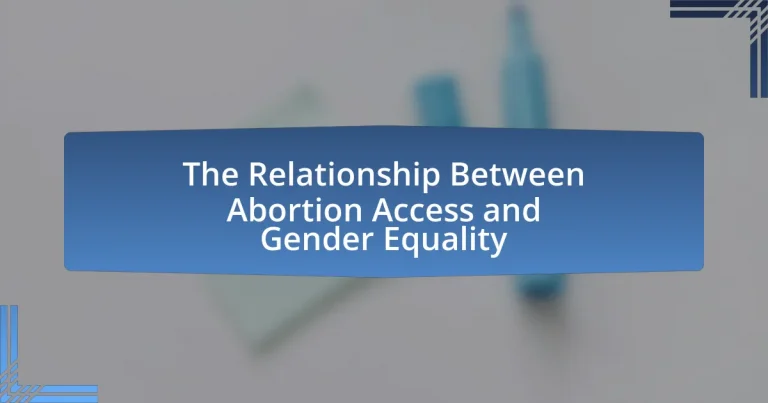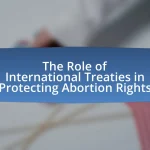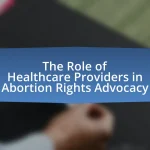The article examines the critical relationship between abortion access and gender equality, highlighting how reproductive rights empower women to make autonomous decisions regarding their health and life choices. It discusses the historical context of abortion laws, the impact of cultural attitudes, and the legal frameworks that support women’s rights to access safe abortion services. The article also explores the socioeconomic factors influencing access to abortion, the implications of limited access on women’s health and economic opportunities, and the role of education and advocacy in promoting reproductive rights. Overall, it emphasizes that improving abortion access is essential for achieving greater gender equality and empowering women in various aspects of society.

What is the relationship between abortion access and gender equality?
Abortion access is fundamentally linked to gender equality, as it empowers individuals to make autonomous decisions about their reproductive health. When women have the ability to access safe and legal abortion services, they can better control their life choices, including education and career opportunities. Research indicates that countries with more liberal abortion laws tend to have higher levels of gender equality, as seen in the Nordic countries, where comprehensive reproductive rights contribute to women’s participation in the workforce and leadership roles. Furthermore, the World Health Organization states that restricted access to abortion disproportionately affects marginalized women, exacerbating existing inequalities. Thus, the relationship between abortion access and gender equality is one of mutual reinforcement, where improved reproductive rights lead to greater gender equity.
How does abortion access influence gender equality?
Abortion access significantly influences gender equality by empowering women to make autonomous decisions about their reproductive health. When women have the ability to choose whether to continue a pregnancy, they can better pursue education and career opportunities, leading to greater economic independence. Research indicates that countries with more liberal abortion laws tend to have higher levels of gender equality, as seen in the Global Gender Gap Report, which highlights that access to reproductive health services is a key factor in closing gender gaps in various sectors. Furthermore, the World Health Organization states that restricted access to safe abortion services can lead to increased maternal mortality and morbidity, disproportionately affecting women’s health and societal participation. Thus, the availability of abortion services is crucial for fostering gender equality by enabling women to exercise their rights and participate fully in society.
What are the historical contexts of abortion access and gender equality?
Abortion access has historically been intertwined with gender equality, reflecting societal attitudes towards women’s autonomy and reproductive rights. In the 19th century, many countries criminalized abortion, limiting women’s control over their bodies and reinforcing patriarchal structures. The feminist movements of the 20th century, particularly in the 1960s and 1970s, advocated for reproductive rights as essential to achieving gender equality, leading to landmark legal changes such as the U.S. Supreme Court’s Roe v. Wade decision in 1973, which recognized a woman’s right to choose. This legal recognition was pivotal in advancing women’s social, economic, and political status, as access to safe abortion services allowed women greater participation in the workforce and education. Historical data shows that countries with more liberal abortion laws tend to have higher gender equality indices, indicating a correlation between reproductive rights and women’s empowerment.
How do cultural attitudes towards abortion affect gender equality?
Cultural attitudes towards abortion significantly impact gender equality by influencing women’s autonomy and access to reproductive health services. In societies where abortion is stigmatized or restricted, women often face barriers to making choices about their own bodies, which can limit their participation in education and the workforce. For instance, research from the Guttmacher Institute indicates that countries with restrictive abortion laws tend to have higher rates of maternal mortality and morbidity, which disproportionately affects women’s health and economic opportunities. Furthermore, cultural norms that prioritize traditional gender roles can perpetuate inequalities, as women may be pressured to conform to expectations that limit their reproductive choices. Thus, positive cultural attitudes towards abortion can enhance gender equality by promoting women’s rights and health, while negative attitudes can reinforce systemic inequalities.
Why is abortion access considered a fundamental aspect of women’s rights?
Abortion access is considered a fundamental aspect of women’s rights because it directly impacts women’s autonomy over their bodies and reproductive choices. This autonomy is essential for achieving gender equality, as it allows women to make decisions that affect their health, economic stability, and social participation. Research indicates that when women have control over their reproductive health, they are more likely to pursue education and employment opportunities, contributing to their empowerment and societal advancement. For instance, the Guttmacher Institute reports that access to safe and legal abortion services is linked to improved health outcomes and economic well-being for women, reinforcing the notion that reproductive rights are integral to women’s rights overall.
What legal frameworks support abortion access as a women’s right?
Legal frameworks that support abortion access as a women’s right include international human rights treaties, national constitutions, and specific legislation. The Convention on the Elimination of All Forms of Discrimination Against Women (CEDAW) emphasizes women’s rights to make decisions about their reproductive health, which includes access to safe abortion services. Additionally, many countries’ constitutions, such as those in Canada and South Africa, explicitly protect reproductive rights, affirming the right to access abortion. National laws in various jurisdictions, like the Roe v. Wade decision in the United States, have established legal precedents that recognize abortion as a constitutional right, further reinforcing women’s autonomy over their bodies.
How do restrictions on abortion access impact women’s health and autonomy?
Restrictions on abortion access significantly undermine women’s health and autonomy by limiting their ability to make informed choices about their reproductive health. When access to safe and legal abortion services is restricted, women may resort to unsafe methods, leading to increased rates of maternal morbidity and mortality. According to the World Health Organization, unsafe abortions account for approximately 13% of maternal deaths globally, highlighting the direct health risks associated with restricted access. Furthermore, these restrictions can perpetuate gender inequality by denying women control over their bodies and reproductive decisions, which is essential for achieving gender equality. Studies show that when women have the autonomy to make decisions about their reproductive health, they experience better health outcomes and greater participation in social and economic activities. Thus, restrictions on abortion access not only jeopardize women’s health but also hinder their autonomy and equality in society.
What are the global disparities in abortion access and gender equality?
Global disparities in abortion access and gender equality are significant, with many countries enforcing restrictive laws that limit women’s reproductive rights. For instance, in regions like Sub-Saharan Africa and parts of Latin America, legal barriers and cultural stigmas severely restrict access to safe abortion services, contributing to higher maternal mortality rates. According to the World Health Organization, unsafe abortions account for approximately 13% of maternal deaths globally, highlighting the critical link between limited abortion access and gender inequality. In contrast, countries with more progressive reproductive health policies, such as Canada and many European nations, demonstrate higher levels of gender equality, as women have greater autonomy over their reproductive choices. This correlation suggests that improving abortion access can enhance gender equality by empowering women to make informed decisions about their bodies and futures.
Which countries have the most restrictive abortion laws and how does this relate to gender equality?
Countries with the most restrictive abortion laws include El Salvador, Nicaragua, and Malta, where abortion is either completely banned or allowed only in very limited circumstances. These restrictive laws significantly impact gender equality by limiting women’s autonomy over their reproductive health, thereby reinforcing gender disparities. Research indicates that in countries with stringent abortion laws, women often face increased health risks, economic disadvantages, and social stigmatization, which collectively hinder their ability to participate equally in society. For instance, the World Health Organization reports that restrictive abortion laws correlate with higher rates of unsafe abortions, which disproportionately affect women’s health and well-being, further entrenching gender inequality.
How do socioeconomic factors influence access to abortion services?
Socioeconomic factors significantly influence access to abortion services by determining individuals’ financial resources, education levels, and geographic location. Individuals with lower income often face barriers such as the inability to afford the procedure, travel costs to clinics, and lack of insurance coverage, which can limit their access to safe abortion services. For instance, a study by the Guttmacher Institute found that women living below the federal poverty level are more likely to experience difficulties in obtaining abortion services compared to those with higher incomes. Additionally, education plays a crucial role; individuals with higher education levels are generally more informed about their reproductive rights and available services. Geographic disparities also affect access, as rural areas often have fewer clinics, making it harder for individuals in those regions to obtain abortions. Thus, socioeconomic factors create a multifaceted barrier to accessing abortion services, impacting women’s reproductive autonomy and overall gender equality.
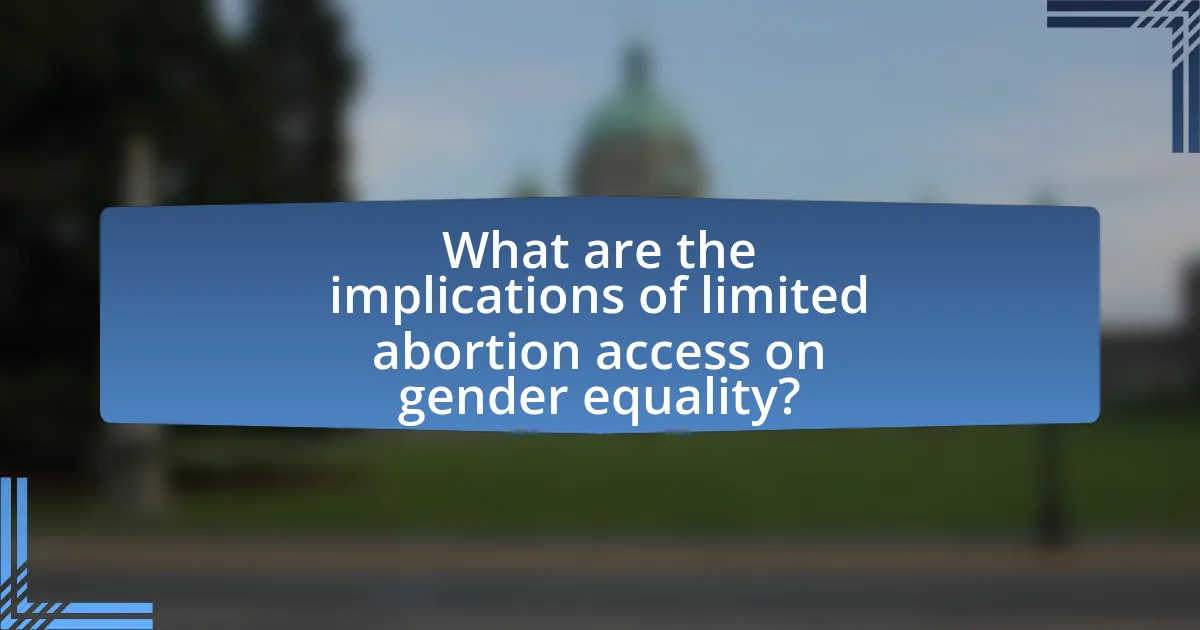
What are the implications of limited abortion access on gender equality?
Limited abortion access negatively impacts gender equality by restricting women’s autonomy over their reproductive choices. This limitation can lead to increased economic disparities, as women may face challenges in pursuing education and career opportunities when they cannot control their reproductive health. Research indicates that countries with restrictive abortion laws often experience higher rates of maternal mortality and morbidity, which disproportionately affect women and hinder their participation in society. For instance, a study published in The Lancet found that unsafe abortions contribute significantly to maternal deaths, particularly in regions with limited access to safe abortion services, thereby exacerbating gender inequality.
How does limited access to abortion services affect women’s economic opportunities?
Limited access to abortion services significantly restricts women’s economic opportunities by forcing them to carry unwanted pregnancies to term, which can hinder their ability to pursue education and stable employment. Research indicates that women who have access to abortion services are more likely to complete their education and participate in the workforce, leading to higher earning potential. For instance, a study published in the American Journal of Public Health found that women who were denied abortions were more likely to experience economic hardship and rely on public assistance compared to those who had access to abortion services. This correlation underscores how reproductive autonomy directly influences women’s economic stability and overall gender equality in the labor market.
What role does education play in the relationship between abortion access and economic empowerment?
Education significantly enhances the relationship between abortion access and economic empowerment by equipping individuals with knowledge and skills that facilitate informed decision-making regarding reproductive health. Studies indicate that higher levels of education correlate with increased access to abortion services, which in turn allows individuals to make choices that align with their economic goals. For instance, research published in the American Journal of Public Health shows that women with higher educational attainment are more likely to utilize reproductive health services, including abortion, leading to better economic outcomes such as higher income and employment rates. This connection underscores the importance of education in enabling individuals to navigate their reproductive choices effectively, thereby fostering economic independence and empowerment.
How do unintended pregnancies impact women’s career trajectories?
Unintended pregnancies significantly disrupt women’s career trajectories by limiting their educational and professional opportunities. Research indicates that women who experience unintended pregnancies are more likely to drop out of school or reduce their work hours, which can lead to long-term economic disadvantages. For instance, a study published in the American Journal of Public Health found that women who had unintended pregnancies were 30% more likely to be unemployed compared to their peers who did not experience such pregnancies. This disruption not only affects immediate job prospects but also hinders career advancement and earning potential over time, contributing to persistent gender inequality in the workforce.
What are the psychological effects of restricted abortion access on women?
Restricted abortion access significantly impacts women’s psychological well-being, leading to increased levels of anxiety, depression, and feelings of helplessness. Research indicates that women denied abortions are more likely to experience mental health issues compared to those who have access; for instance, a study published in the journal “JAMA Psychiatry” found that women who were denied an abortion reported higher levels of anxiety and lower life satisfaction over a five-year period. Furthermore, the stress associated with unwanted pregnancies can exacerbate existing mental health conditions and lead to long-term emotional distress. These psychological effects underscore the critical link between reproductive rights and women’s mental health, highlighting the importance of accessible abortion services for promoting gender equality.
How does mental health correlate with access to reproductive healthcare?
Mental health significantly correlates with access to reproductive healthcare, as individuals with mental health issues often face barriers that limit their ability to obtain necessary reproductive services. Research indicates that mental health conditions can lead to increased stigma, discrimination, and lack of support, which in turn affects access to healthcare resources. For instance, a study published in the American Journal of Public Health found that women with mental health disorders are less likely to receive reproductive healthcare services, including contraception and abortion, due to both systemic barriers and personal challenges related to their mental health. This correlation highlights the importance of integrating mental health support within reproductive healthcare services to improve access and outcomes for affected individuals.
What support systems are necessary for women facing unintended pregnancies?
Women facing unintended pregnancies require comprehensive support systems that include access to healthcare services, emotional support, financial assistance, and legal resources. Access to healthcare services is crucial, as it provides women with necessary medical care, including prenatal care and counseling options. Emotional support from family, friends, and community organizations can help women navigate the psychological challenges associated with unintended pregnancies. Financial assistance programs can alleviate the economic burden, enabling women to make informed choices regarding their pregnancies. Legal resources are also essential to ensure that women understand their rights and options, including access to safe abortion services where legal. Studies indicate that comprehensive support systems significantly improve outcomes for women facing unintended pregnancies, highlighting the importance of integrated care and resources in promoting gender equality.
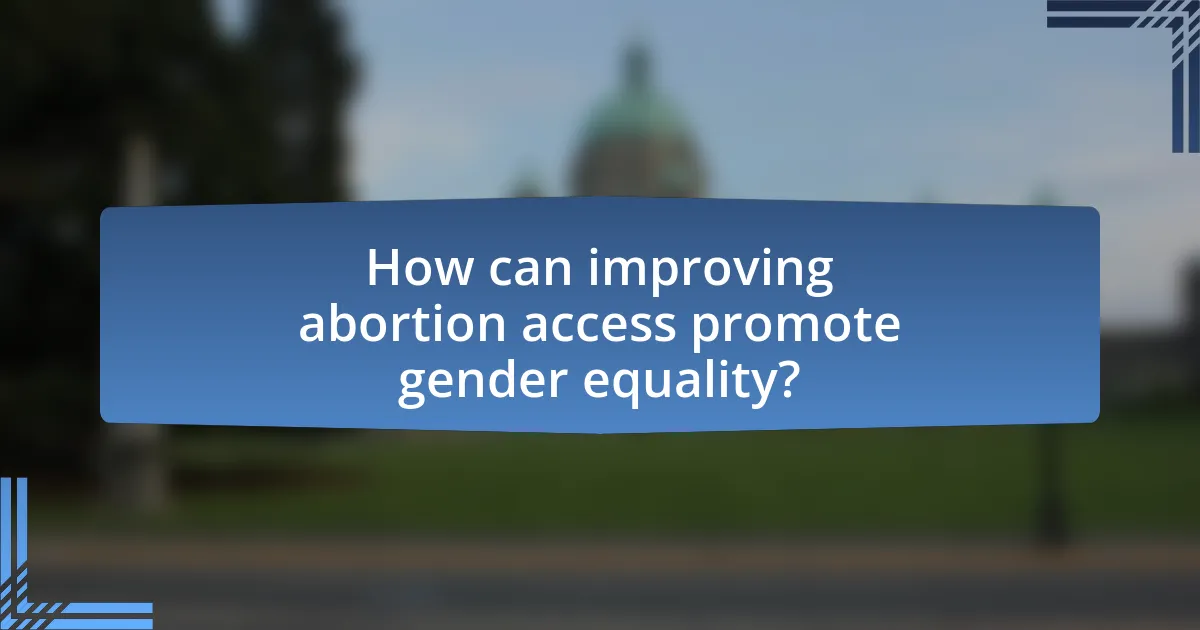
How can improving abortion access promote gender equality?
Improving abortion access promotes gender equality by empowering women to make autonomous decisions about their reproductive health. When women have the ability to choose whether and when to have children, they can pursue education and career opportunities more freely, leading to greater economic independence. Research indicates that countries with more accessible abortion services tend to have higher levels of gender equality, as women are better able to participate in the workforce and public life. For instance, a study published in the American Journal of Public Health found that increased access to abortion services correlates with improved educational attainment and economic outcomes for women, thereby reinforcing the link between reproductive rights and gender equality.
What policies can enhance abortion access and support gender equality?
Policies that can enhance abortion access and support gender equality include the implementation of comprehensive reproductive health services, including abortion care, as part of universal healthcare systems. Such policies ensure that all individuals have access to safe and legal abortion services, which is crucial for gender equality, as it empowers women to make decisions about their own bodies and reproductive health.
Evidence shows that countries with more liberal abortion laws and comprehensive reproductive health services experience lower rates of maternal mortality and morbidity. For instance, the World Health Organization reports that access to safe abortion services significantly reduces health risks associated with unsafe procedures, thereby promoting gender equality by safeguarding women’s health and autonomy.
Additionally, policies that provide education on reproductive rights and access to contraception can further enhance abortion access and support gender equality by preventing unintended pregnancies and allowing women to plan their families.
How do comprehensive reproductive health services contribute to gender equality?
Comprehensive reproductive health services contribute to gender equality by empowering women to make informed choices about their bodies and reproductive health. Access to these services, including contraception, prenatal care, and safe abortion, enables women to control their reproductive lives, which is essential for achieving educational and economic opportunities. Studies show that when women have access to reproductive health services, they are more likely to participate in the workforce and pursue higher education, leading to greater gender parity in various sectors. For instance, the Guttmacher Institute reports that increased access to contraception can reduce unintended pregnancies by 40%, allowing women to plan their families and careers effectively. This empowerment fosters a more equitable society where women can fully engage in social, political, and economic spheres.
What role do advocacy groups play in promoting abortion access?
Advocacy groups play a crucial role in promoting abortion access by mobilizing public support, influencing policy, and providing resources for individuals seeking reproductive health services. These organizations, such as Planned Parenthood and the Center for Reproductive Rights, engage in grassroots campaigns to raise awareness about the importance of abortion access as a fundamental aspect of women’s rights and gender equality. They also lobby lawmakers to protect and expand reproductive rights, often citing studies that demonstrate the positive impact of accessible abortion services on women’s health and socioeconomic status. For instance, research published in the American Journal of Public Health indicates that access to abortion services significantly reduces maternal mortality rates, underscoring the critical role advocacy groups play in ensuring safe and legal abortion options.
What best practices can be implemented to ensure equitable access to abortion services?
To ensure equitable access to abortion services, implementing comprehensive policies that include legal protections, funding for clinics, and education on reproductive rights is essential. Legal protections, such as the decriminalization of abortion and the establishment of safe zones around clinics, can reduce barriers for individuals seeking services. Funding for clinics, particularly in underserved areas, ensures that services are available regardless of socioeconomic status. Additionally, education initiatives that inform individuals about their reproductive rights and available services can empower them to seek care without stigma. Research indicates that countries with supportive legal frameworks and accessible services experience lower rates of unsafe abortions, highlighting the importance of these best practices in promoting gender equality and health equity.
How can education and awareness campaigns improve public perception of abortion access?
Education and awareness campaigns can significantly improve public perception of abortion access by providing accurate information and dispelling myths surrounding the topic. These campaigns educate the public about the medical, social, and economic implications of abortion, which can lead to a more informed and empathetic understanding of the issue. For instance, studies have shown that when individuals are exposed to factual information about abortion, including its safety and the circumstances that lead individuals to seek it, their attitudes often shift towards greater support for access. Research published in the journal “Health Affairs” indicates that comprehensive sex education and awareness initiatives correlate with increased public support for reproductive rights, highlighting the effectiveness of these campaigns in shaping perceptions.
What community resources are essential for supporting women’s reproductive rights?
Essential community resources for supporting women’s reproductive rights include access to comprehensive healthcare services, educational programs on reproductive health, legal assistance for navigating reproductive rights, and support networks such as advocacy groups. Comprehensive healthcare services, including family planning and abortion services, are crucial as they provide women with necessary medical care. Educational programs empower women with knowledge about their reproductive health, enabling informed decision-making. Legal assistance helps women understand and exercise their rights, particularly in restrictive environments. Support networks, including organizations like Planned Parenthood and the National Abortion Federation, offer resources and advocacy, reinforcing the importance of reproductive rights in achieving gender equality.
